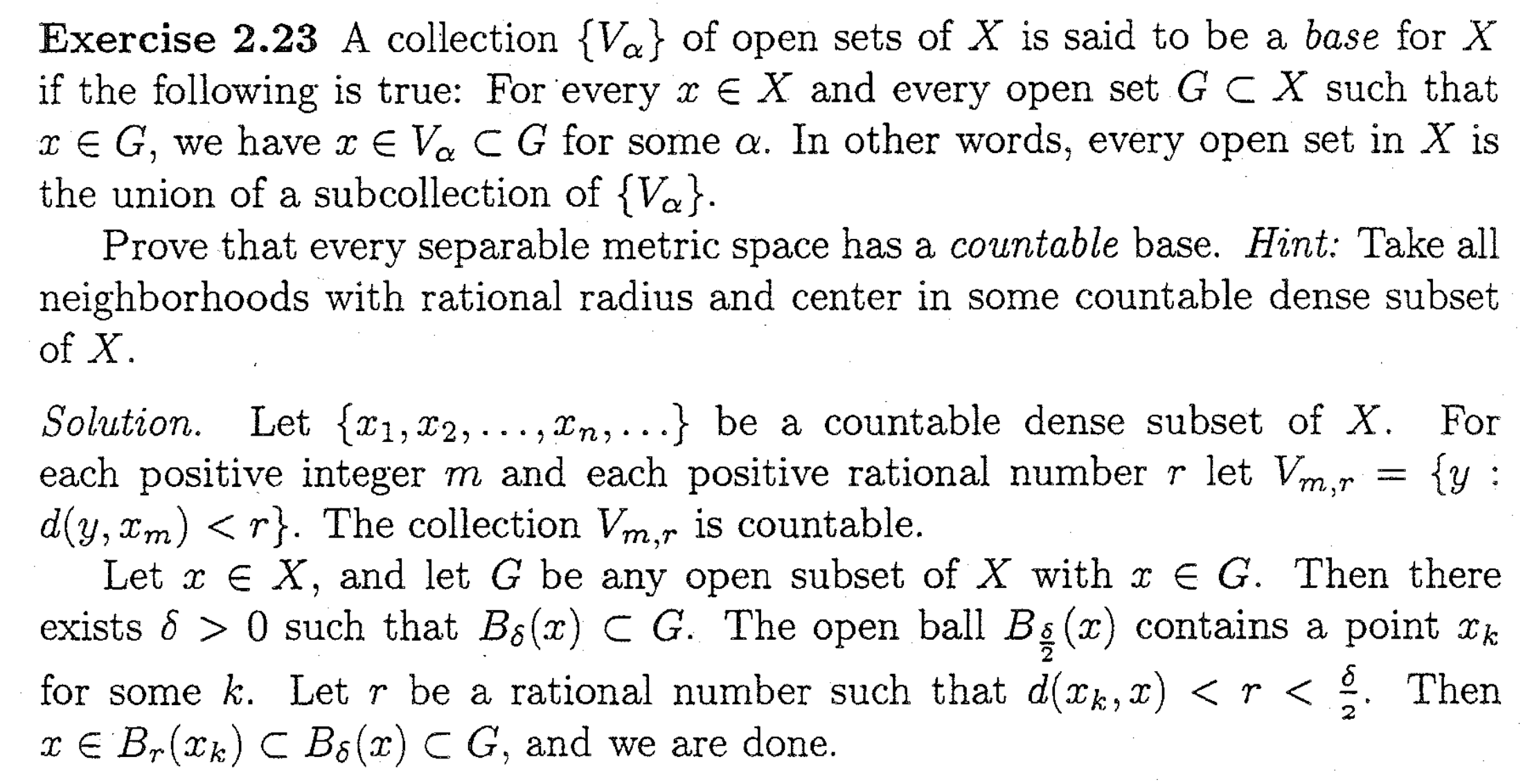Rudin Analysis Exercise 2.23
Rudin E2.23
This question is a prerequisite for Exercise 2.25, which corresponds to the Exercise 43.4 in Foundations of Mathematical Analysis
Question
Exercise 2.23 A collection \({V_α}\) of open sets of \(X\) is said to be a base for \(X\) if the following is true: For every \(x \in X\) and every open set \(G \subset X\) such that \(x \in G\) , we have \(x \in V_\alpha \subset G\) for some \(\alpha\). In other words, every open set in \(X\) is the union of a subcollection of \({V_\alpha}\). Prove that every separable metric space has a countable base. Hint: Take all neighborhoods with rational radius and center in some countable dense subset of \(X\).
A metric space is called separable if it contains a countable dense subset.
Understand:
For this question, we need to prove two things: there is a base and the base is countable (remember base is a collection of set—set of set).
We are given that \(X\) is separable. This is a hint itself. \(X\) will contain a countable dense subset. This provide a feature of countable.
If we see the hint, we can also connect the countability with the rational radius.
Prove:
Since \(X\) is separable, let \(\{x_1, x_2, …\}\) be a dense (also countable) subset of \(X\).
\(\forall m \in \Bbb{N}, r\in \Bbb{Q}, r \gt 0\), we let \(V_{m, r} = \{y : y \in N_{r}(x_m)\}\).
Since \(\Bbb{Q}, \Bbb{N}\) are both countable, thus the collection of \(V_{m, r}\) is countable.
(Notice this is not saying that \(V_{m, r}\) is countable, this is saying that \(\{V_{m, r}\}_{m, r}\) is countable)
Let \(V = \{V_{m, r}\}\)
Also, \(V_{m, r}\) is open. (Actually \(V_{m, r} = N_{r}(x_m)\), which is open.)
Thus we found a countable collection of open set \(V\).
Now we will prove this \(V\) is a base for \(X\).
To achieve this, we generally want to show: \(\forall \ open \ G \subset X, \exists V_{m,r} \in V: V \subset G\)
Yet this is of course not enough, to we actually need to also show that for all points in \(G\), there is a \(V_{m, r} \in V\) such that this point also in \(V_{m, r}\)
Let \(x \in X\), \(\exists \ open \ G: x \in G\). Since \(G\) is open, all points in \(G\) must be interior points of \(G\).
Thus \(x\) is an interior point of \(G\). Thus, \(\exists \delta: N_\delta(x) \in G\).
Since \(\{x_1, x_2, …\}\) is dense in \(X\), \(\exists k \in N: x_k \in N_{\frac{\delta}{2}}(x)\).
This also means that \(x \in N_{\frac{\delta}{2}}(x_k)\). Thus \(x \in V_{k, \frac{\delta}{2}}\). Thus, \(V\) is a base of \(X\).
The original proof I saw was from

https://minds.wisconsin.edu/bitstream/handle/1793/67009/rudin ch 2.pdf?sequence=10&isAllowed=y
I was wondering the following questions:
- Why we need rational radius.
- Why do we always have such \(x_k\) in the open ball.
- What is the second part doing.
I provided my understanding of the proof.